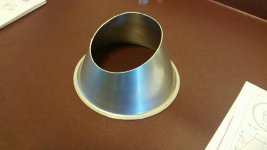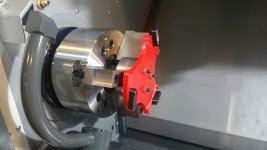racer8432955
Plastic
- Joined
- Feb 10, 2020
- Location
- Kenosha, WI USA
Hello All.
My first post here seeking help as I am a true amateur, just been reading and lurking around for about the last 1/2 year. I'm not a machinist, but a product development guy that for the last 20+ years has been involved in anything and everything working for small companies can dream up. Part way thru last year my company decided to take on metal spinning under our suite of services (sheet metal fab).
Steel tools are made on our Haas ST20Y (by me). The spinnings (generally .050" thk 1100-0 series aluminum sheet) are done on an Italian made spinning specific machine. While this is a niche market, there is nothing to unique so far in what I have described. However, the manner in which we are cutting secondary features into parts is. We are attempting to cut them on our ST20Y, which I have had some success so far, as opposed to a 5 axis laser as most spinners use. Parts are fixtured in 3d printed holders mounted to a steel arbor, which is clamped in the 3 jaw chuck.
My goals are to reduce the burr, or minimize deburring after the cut. Speed: what I have pictured is cutting about an 8" dia, my best cuts so far have taken about 2.5 minutes total cycle time (single pass cut). This is not too bad in relationship to our costs, but of course we would like to do better. Tolerances; don't fall out of you chair machinists but commonly we will be given +/- .030".
My best cuts so far were using a 3mm / 4 Flute uncoated china/ebay hss end mill. Machine is limited to 4000 rpm. SFM= 123 ft/min & Cutting Feedrate= 20.6 in/min.
So... my question is, does anyone have a good / better / perfect baseline on where to start with cutters, feeds & speeds, and technique for accomplishing this??
Thanks!




My first post here seeking help as I am a true amateur, just been reading and lurking around for about the last 1/2 year. I'm not a machinist, but a product development guy that for the last 20+ years has been involved in anything and everything working for small companies can dream up. Part way thru last year my company decided to take on metal spinning under our suite of services (sheet metal fab).
Steel tools are made on our Haas ST20Y (by me). The spinnings (generally .050" thk 1100-0 series aluminum sheet) are done on an Italian made spinning specific machine. While this is a niche market, there is nothing to unique so far in what I have described. However, the manner in which we are cutting secondary features into parts is. We are attempting to cut them on our ST20Y, which I have had some success so far, as opposed to a 5 axis laser as most spinners use. Parts are fixtured in 3d printed holders mounted to a steel arbor, which is clamped in the 3 jaw chuck.
My goals are to reduce the burr, or minimize deburring after the cut. Speed: what I have pictured is cutting about an 8" dia, my best cuts so far have taken about 2.5 minutes total cycle time (single pass cut). This is not too bad in relationship to our costs, but of course we would like to do better. Tolerances; don't fall out of you chair machinists but commonly we will be given +/- .030".
My best cuts so far were using a 3mm / 4 Flute uncoated china/ebay hss end mill. Machine is limited to 4000 rpm. SFM= 123 ft/min & Cutting Feedrate= 20.6 in/min.
So... my question is, does anyone have a good / better / perfect baseline on where to start with cutters, feeds & speeds, and technique for accomplishing this??
Thanks!








